A Study of Consumer Adoption of Hisense in the Nigerian Market
VerifiedAdded on 2023/04/21
|29
|5716
|61
Thesis and Dissertation
AI Summary
This dissertation examines the determinants of consumer adoption of less premium brands, specifically focusing on the Hisense brand within the Nigerian electronic goods market. The study investigates the market's performance, driven by factors like foreign exchange stability, the influx of Chinese products, and a growing millennial population. The research aims to identify factors influencing consumer choices between premium and non-premium brands, employing primary data collection methods. The dissertation includes an introduction outlining the background, problem statement, objectives, research questions, and hypotheses. It also encompasses a literature review, exploring conceptual and theoretical frameworks, including the buying behavior model. The methodology section details the research design, population, sampling, data validation, and analysis methods. The findings, data presentation, and analysis are presented, followed by a summary, conclusions, and recommendations. The research explores the influence of product pricing, social media, and personal factors such as lifestyle and income on consumer adoption of less premium brands, offering insights for companies like Hisense to refine their market strategies.
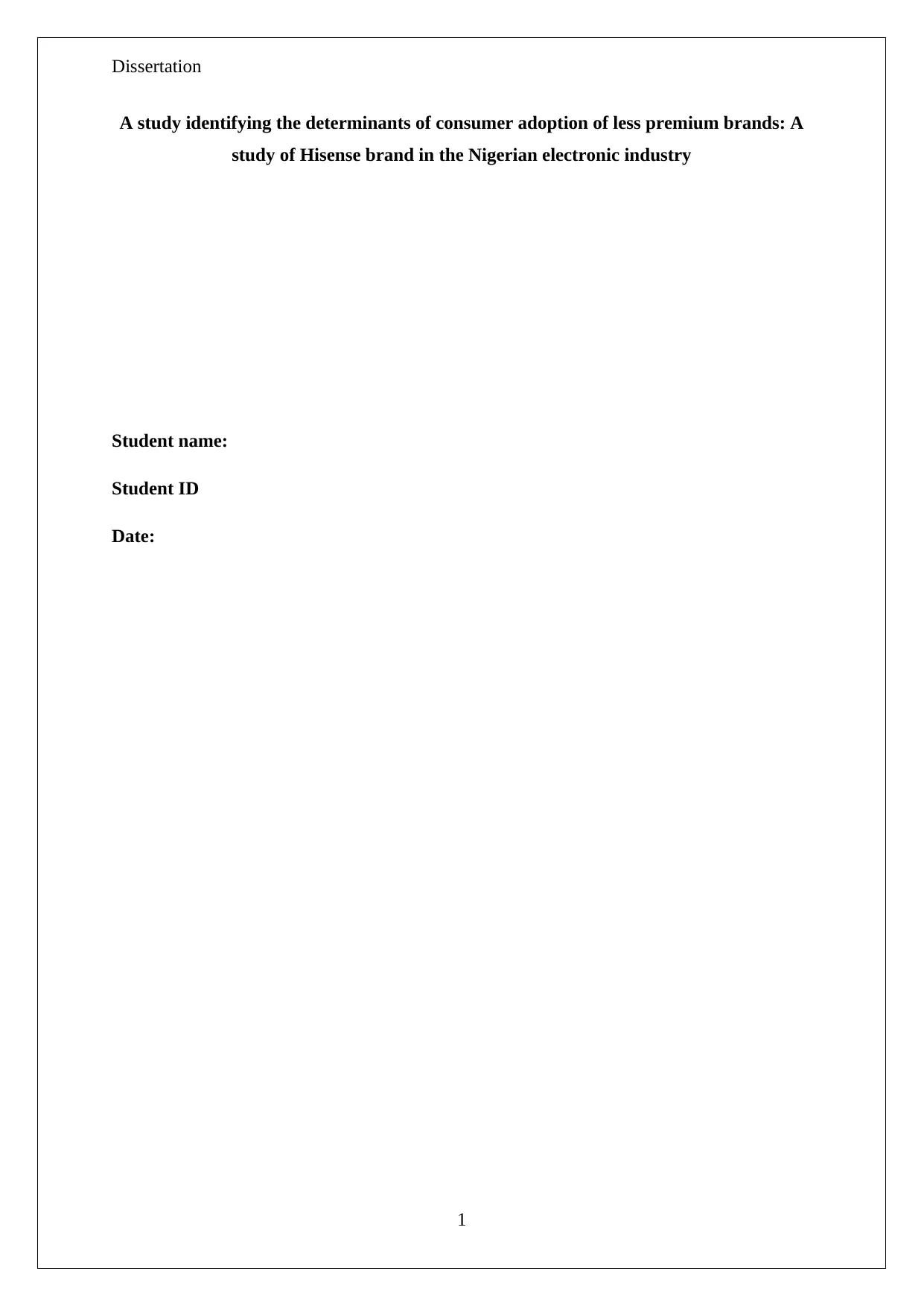
Dissertation
A study identifying the determinants of consumer adoption of less premium brands: A
study of Hisense brand in the Nigerian electronic industry
Student name:
Student ID
Date:
1
A study identifying the determinants of consumer adoption of less premium brands: A
study of Hisense brand in the Nigerian electronic industry
Student name:
Student ID
Date:
1
Paraphrase This Document
Need a fresh take? Get an instant paraphrase of this document with our AI Paraphraser
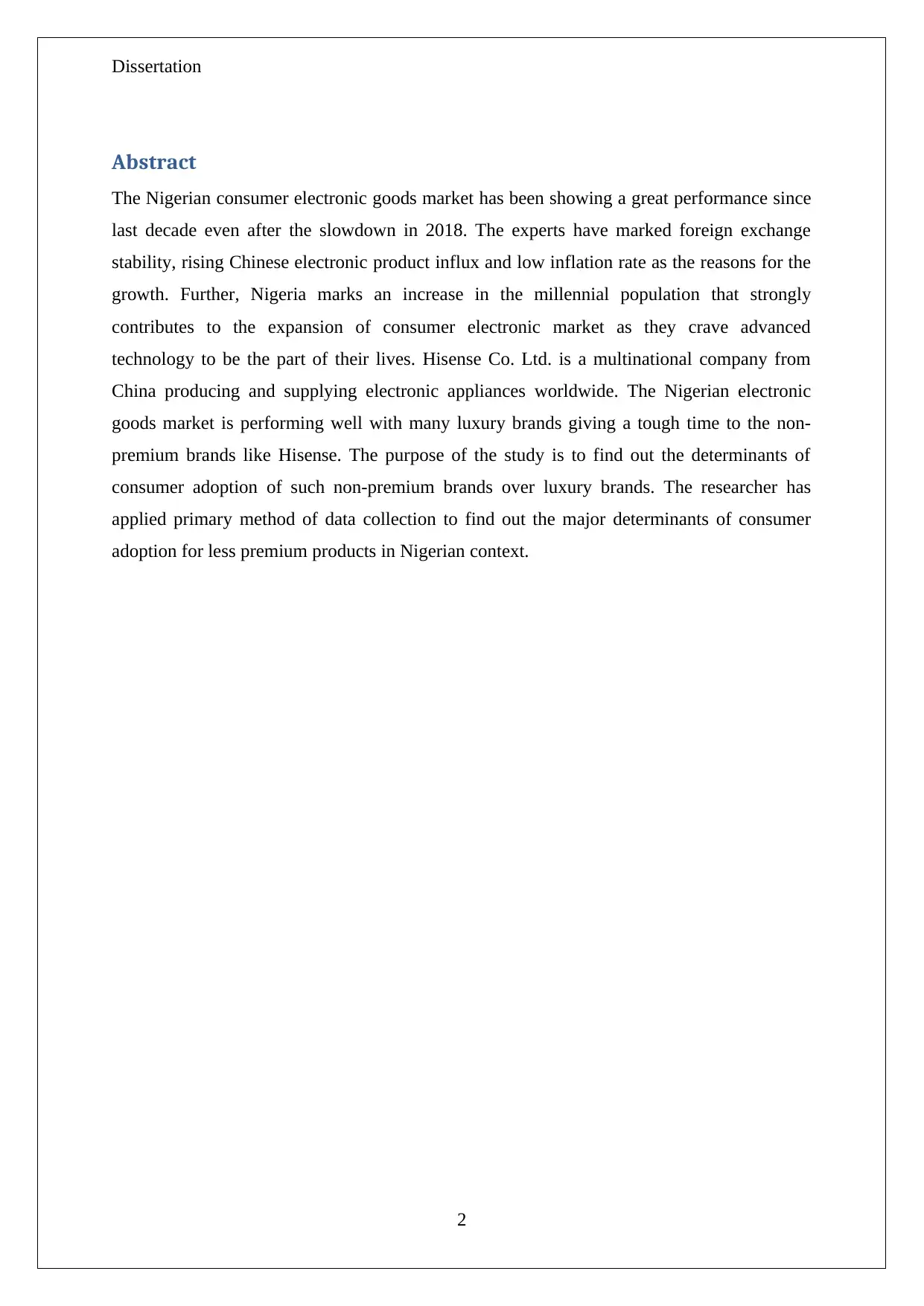
Dissertation
Abstract
The Nigerian consumer electronic goods market has been showing a great performance since
last decade even after the slowdown in 2018. The experts have marked foreign exchange
stability, rising Chinese electronic product influx and low inflation rate as the reasons for the
growth. Further, Nigeria marks an increase in the millennial population that strongly
contributes to the expansion of consumer electronic market as they crave advanced
technology to be the part of their lives. Hisense Co. Ltd. is a multinational company from
China producing and supplying electronic appliances worldwide. The Nigerian electronic
goods market is performing well with many luxury brands giving a tough time to the non-
premium brands like Hisense. The purpose of the study is to find out the determinants of
consumer adoption of such non-premium brands over luxury brands. The researcher has
applied primary method of data collection to find out the major determinants of consumer
adoption for less premium products in Nigerian context.
2
Abstract
The Nigerian consumer electronic goods market has been showing a great performance since
last decade even after the slowdown in 2018. The experts have marked foreign exchange
stability, rising Chinese electronic product influx and low inflation rate as the reasons for the
growth. Further, Nigeria marks an increase in the millennial population that strongly
contributes to the expansion of consumer electronic market as they crave advanced
technology to be the part of their lives. Hisense Co. Ltd. is a multinational company from
China producing and supplying electronic appliances worldwide. The Nigerian electronic
goods market is performing well with many luxury brands giving a tough time to the non-
premium brands like Hisense. The purpose of the study is to find out the determinants of
consumer adoption of such non-premium brands over luxury brands. The researcher has
applied primary method of data collection to find out the major determinants of consumer
adoption for less premium products in Nigerian context.
2
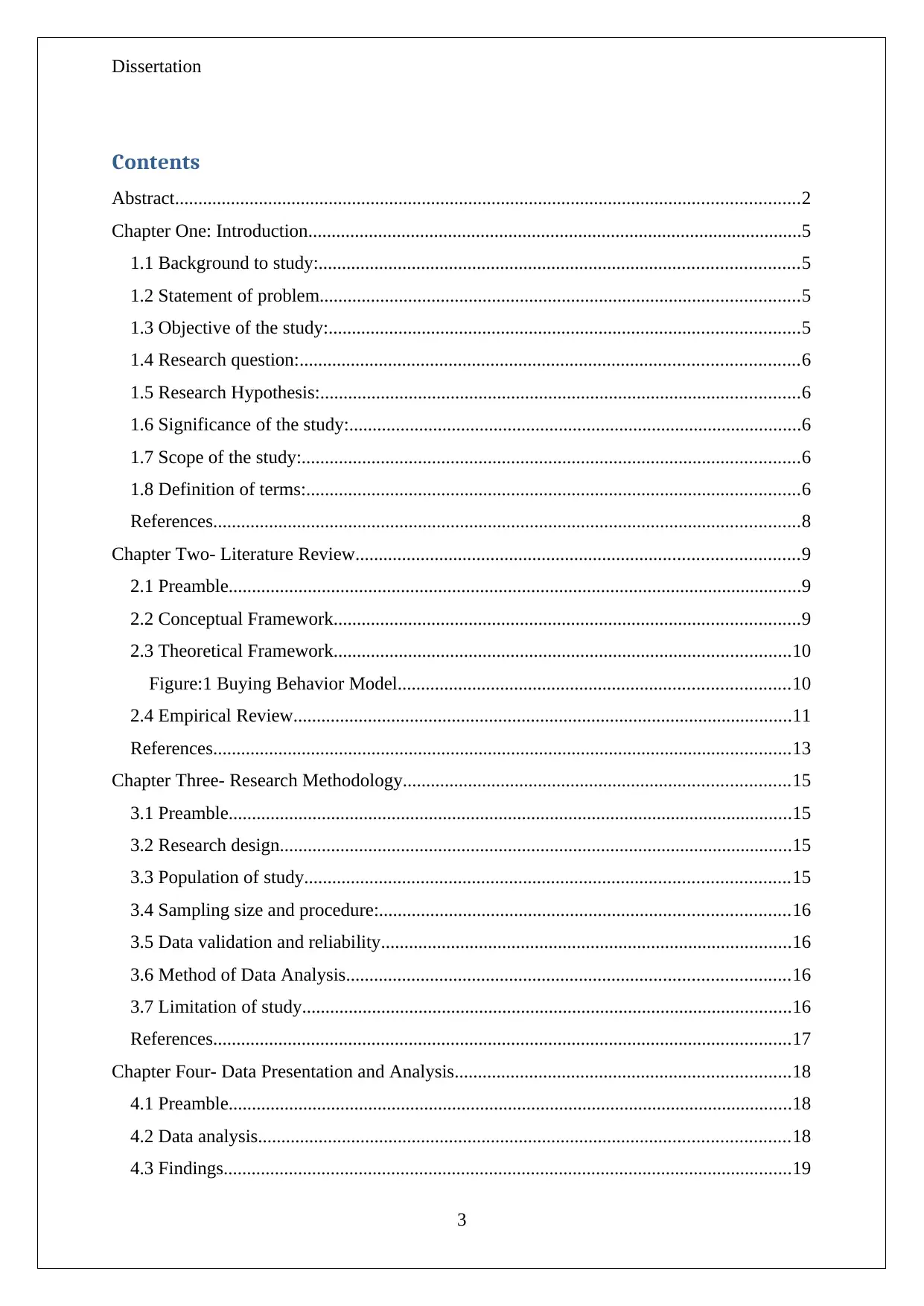
Dissertation
Contents
Abstract......................................................................................................................................2
Chapter One: Introduction..........................................................................................................5
1.1 Background to study:.......................................................................................................5
1.2 Statement of problem.......................................................................................................5
1.3 Objective of the study:.....................................................................................................5
1.4 Research question:...........................................................................................................6
1.5 Research Hypothesis:.......................................................................................................6
1.6 Significance of the study:.................................................................................................6
1.7 Scope of the study:...........................................................................................................6
1.8 Definition of terms:..........................................................................................................6
References..............................................................................................................................8
Chapter Two- Literature Review...............................................................................................9
2.1 Preamble...........................................................................................................................9
2.2 Conceptual Framework....................................................................................................9
2.3 Theoretical Framework..................................................................................................10
Figure:1 Buying Behavior Model....................................................................................10
2.4 Empirical Review...........................................................................................................11
References............................................................................................................................13
Chapter Three- Research Methodology...................................................................................15
3.1 Preamble.........................................................................................................................15
3.2 Research design..............................................................................................................15
3.3 Population of study........................................................................................................15
3.4 Sampling size and procedure:........................................................................................16
3.5 Data validation and reliability........................................................................................16
3.6 Method of Data Analysis...............................................................................................16
3.7 Limitation of study.........................................................................................................16
References............................................................................................................................17
Chapter Four- Data Presentation and Analysis........................................................................18
4.1 Preamble.........................................................................................................................18
4.2 Data analysis..................................................................................................................18
4.3 Findings..........................................................................................................................19
3
Contents
Abstract......................................................................................................................................2
Chapter One: Introduction..........................................................................................................5
1.1 Background to study:.......................................................................................................5
1.2 Statement of problem.......................................................................................................5
1.3 Objective of the study:.....................................................................................................5
1.4 Research question:...........................................................................................................6
1.5 Research Hypothesis:.......................................................................................................6
1.6 Significance of the study:.................................................................................................6
1.7 Scope of the study:...........................................................................................................6
1.8 Definition of terms:..........................................................................................................6
References..............................................................................................................................8
Chapter Two- Literature Review...............................................................................................9
2.1 Preamble...........................................................................................................................9
2.2 Conceptual Framework....................................................................................................9
2.3 Theoretical Framework..................................................................................................10
Figure:1 Buying Behavior Model....................................................................................10
2.4 Empirical Review...........................................................................................................11
References............................................................................................................................13
Chapter Three- Research Methodology...................................................................................15
3.1 Preamble.........................................................................................................................15
3.2 Research design..............................................................................................................15
3.3 Population of study........................................................................................................15
3.4 Sampling size and procedure:........................................................................................16
3.5 Data validation and reliability........................................................................................16
3.6 Method of Data Analysis...............................................................................................16
3.7 Limitation of study.........................................................................................................16
References............................................................................................................................17
Chapter Four- Data Presentation and Analysis........................................................................18
4.1 Preamble.........................................................................................................................18
4.2 Data analysis..................................................................................................................18
4.3 Findings..........................................................................................................................19
3
⊘ This is a preview!⊘
Do you want full access?
Subscribe today to unlock all pages.

Trusted by 1+ million students worldwide
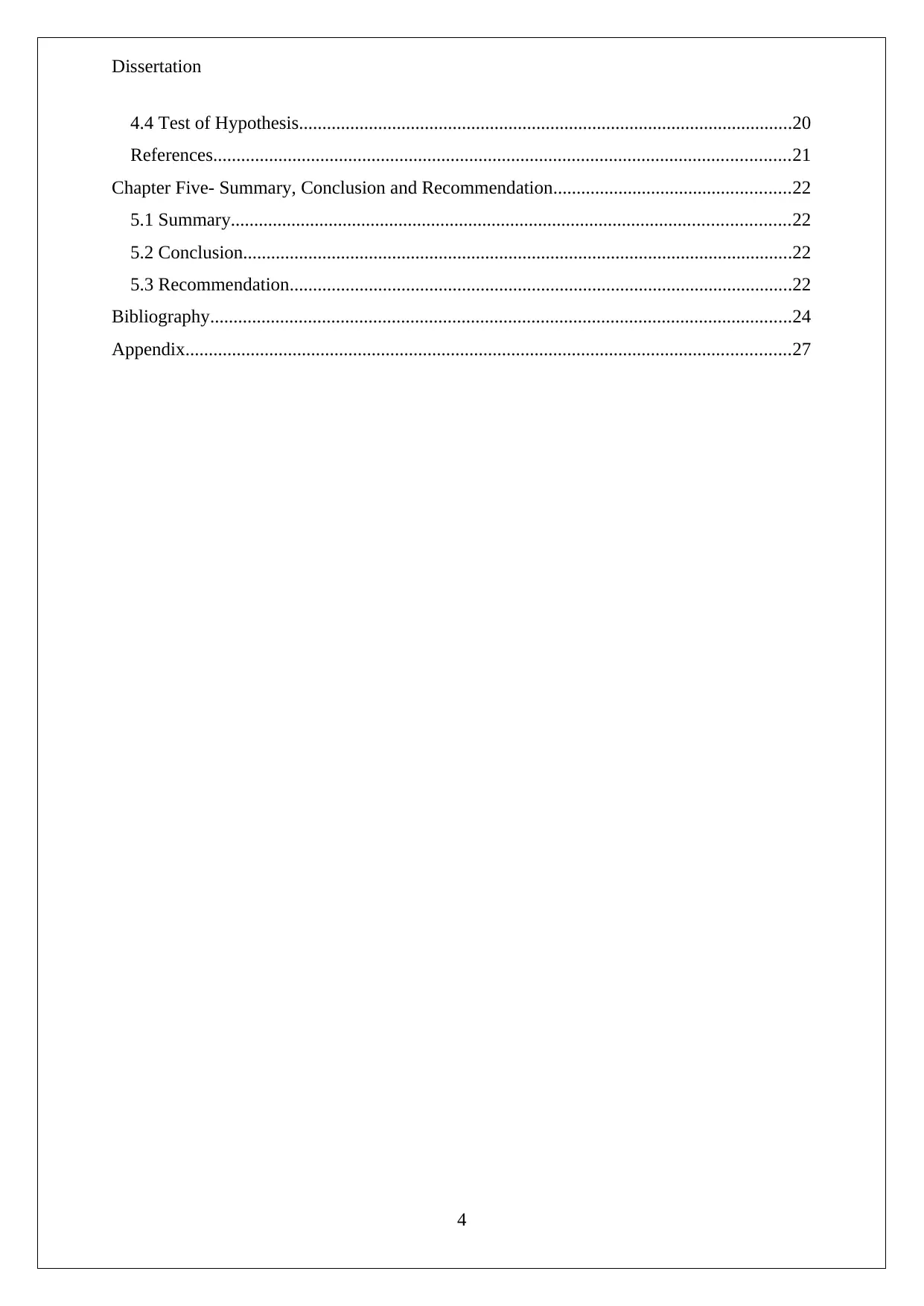
Dissertation
4.4 Test of Hypothesis..........................................................................................................20
References............................................................................................................................21
Chapter Five- Summary, Conclusion and Recommendation...................................................22
5.1 Summary........................................................................................................................22
5.2 Conclusion......................................................................................................................22
5.3 Recommendation............................................................................................................22
Bibliography.............................................................................................................................24
Appendix..................................................................................................................................27
4
4.4 Test of Hypothesis..........................................................................................................20
References............................................................................................................................21
Chapter Five- Summary, Conclusion and Recommendation...................................................22
5.1 Summary........................................................................................................................22
5.2 Conclusion......................................................................................................................22
5.3 Recommendation............................................................................................................22
Bibliography.............................................................................................................................24
Appendix..................................................................................................................................27
4
Paraphrase This Document
Need a fresh take? Get an instant paraphrase of this document with our AI Paraphraser
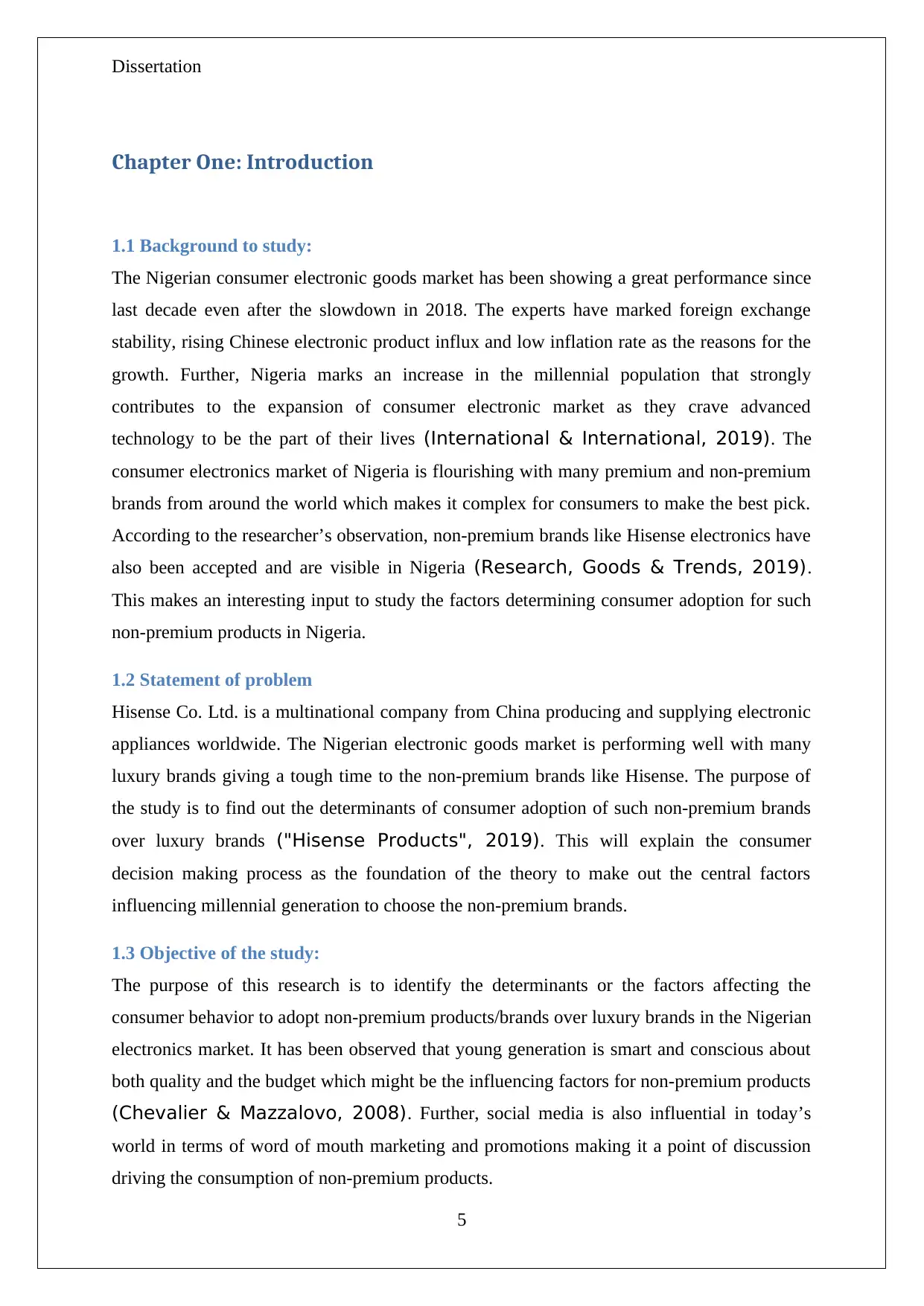
Dissertation
Chapter One: Introduction
1.1 Background to study:
The Nigerian consumer electronic goods market has been showing a great performance since
last decade even after the slowdown in 2018. The experts have marked foreign exchange
stability, rising Chinese electronic product influx and low inflation rate as the reasons for the
growth. Further, Nigeria marks an increase in the millennial population that strongly
contributes to the expansion of consumer electronic market as they crave advanced
technology to be the part of their lives (International & International, 2019). The
consumer electronics market of Nigeria is flourishing with many premium and non-premium
brands from around the world which makes it complex for consumers to make the best pick.
According to the researcher’s observation, non-premium brands like Hisense electronics have
also been accepted and are visible in Nigeria (Research, Goods & Trends, 2019).
This makes an interesting input to study the factors determining consumer adoption for such
non-premium products in Nigeria.
1.2 Statement of problem
Hisense Co. Ltd. is a multinational company from China producing and supplying electronic
appliances worldwide. The Nigerian electronic goods market is performing well with many
luxury brands giving a tough time to the non-premium brands like Hisense. The purpose of
the study is to find out the determinants of consumer adoption of such non-premium brands
over luxury brands ("Hisense Products", 2019). This will explain the consumer
decision making process as the foundation of the theory to make out the central factors
influencing millennial generation to choose the non-premium brands.
1.3 Objective of the study:
The purpose of this research is to identify the determinants or the factors affecting the
consumer behavior to adopt non-premium products/brands over luxury brands in the Nigerian
electronics market. It has been observed that young generation is smart and conscious about
both quality and the budget which might be the influencing factors for non-premium products
(Chevalier & Mazzalovo, 2008). Further, social media is also influential in today’s
world in terms of word of mouth marketing and promotions making it a point of discussion
driving the consumption of non-premium products.
5
Chapter One: Introduction
1.1 Background to study:
The Nigerian consumer electronic goods market has been showing a great performance since
last decade even after the slowdown in 2018. The experts have marked foreign exchange
stability, rising Chinese electronic product influx and low inflation rate as the reasons for the
growth. Further, Nigeria marks an increase in the millennial population that strongly
contributes to the expansion of consumer electronic market as they crave advanced
technology to be the part of their lives (International & International, 2019). The
consumer electronics market of Nigeria is flourishing with many premium and non-premium
brands from around the world which makes it complex for consumers to make the best pick.
According to the researcher’s observation, non-premium brands like Hisense electronics have
also been accepted and are visible in Nigeria (Research, Goods & Trends, 2019).
This makes an interesting input to study the factors determining consumer adoption for such
non-premium products in Nigeria.
1.2 Statement of problem
Hisense Co. Ltd. is a multinational company from China producing and supplying electronic
appliances worldwide. The Nigerian electronic goods market is performing well with many
luxury brands giving a tough time to the non-premium brands like Hisense. The purpose of
the study is to find out the determinants of consumer adoption of such non-premium brands
over luxury brands ("Hisense Products", 2019). This will explain the consumer
decision making process as the foundation of the theory to make out the central factors
influencing millennial generation to choose the non-premium brands.
1.3 Objective of the study:
The purpose of this research is to identify the determinants or the factors affecting the
consumer behavior to adopt non-premium products/brands over luxury brands in the Nigerian
electronics market. It has been observed that young generation is smart and conscious about
both quality and the budget which might be the influencing factors for non-premium products
(Chevalier & Mazzalovo, 2008). Further, social media is also influential in today’s
world in terms of word of mouth marketing and promotions making it a point of discussion
driving the consumption of non-premium products.
5

Dissertation
1.4 Research question:
Main Question: What are the factors affecting consumer adoption of less premium brands?
Sub-questions:
1) Is product pricing more important than quality for consumers?
2) Is social media affecting the consumer decision making process?
3) Are personal factors (lifestyle, budget, preference) affecting the consumer adoption for less
premium brands?
1.5 Research Hypothesis:
H1: Less premium brands like Hisense provide favorable product pricing making it more
preferable for consumers
H2: Millennial buying process is affected by social media marketing
H3: Lifestyle and income preferences are dominating factors in determining the consumer
adoption of less premium brands
1.6 Significance of the study:
This research is important as it aims to identify the determinants of consumer behavior
towards the less premium brands in Nigeria. This can be of great use for companies like
Hisense in understanding consumer behavior in the market and offer their product. This also
will affect the market strategies of less premium products in the electronic market to attract
more customers and increase its sales.
1.7 Scope of the study:
The study is limited to the consumer behavior towards less premium products. The study
covers consumers of age group 20-50 years from Nigeria only. The study is limited to the
application in the consumer electronic product market itself. The study is not limited to
certain specific types of people. All the types of consumers have been included in the survey.
Determinants of consumer adoption considered include product and personal factors.
1.8 Definition of terms:
Less premium brand: A brand that is not perceived to be costly and fulfills the basic
requirements of the customer. Not considered in the category of luxury products
6
1.4 Research question:
Main Question: What are the factors affecting consumer adoption of less premium brands?
Sub-questions:
1) Is product pricing more important than quality for consumers?
2) Is social media affecting the consumer decision making process?
3) Are personal factors (lifestyle, budget, preference) affecting the consumer adoption for less
premium brands?
1.5 Research Hypothesis:
H1: Less premium brands like Hisense provide favorable product pricing making it more
preferable for consumers
H2: Millennial buying process is affected by social media marketing
H3: Lifestyle and income preferences are dominating factors in determining the consumer
adoption of less premium brands
1.6 Significance of the study:
This research is important as it aims to identify the determinants of consumer behavior
towards the less premium brands in Nigeria. This can be of great use for companies like
Hisense in understanding consumer behavior in the market and offer their product. This also
will affect the market strategies of less premium products in the electronic market to attract
more customers and increase its sales.
1.7 Scope of the study:
The study is limited to the consumer behavior towards less premium products. The study
covers consumers of age group 20-50 years from Nigeria only. The study is limited to the
application in the consumer electronic product market itself. The study is not limited to
certain specific types of people. All the types of consumers have been included in the survey.
Determinants of consumer adoption considered include product and personal factors.
1.8 Definition of terms:
Less premium brand: A brand that is not perceived to be costly and fulfills the basic
requirements of the customer. Not considered in the category of luxury products
6
⊘ This is a preview!⊘
Do you want full access?
Subscribe today to unlock all pages.

Trusted by 1+ million students worldwide
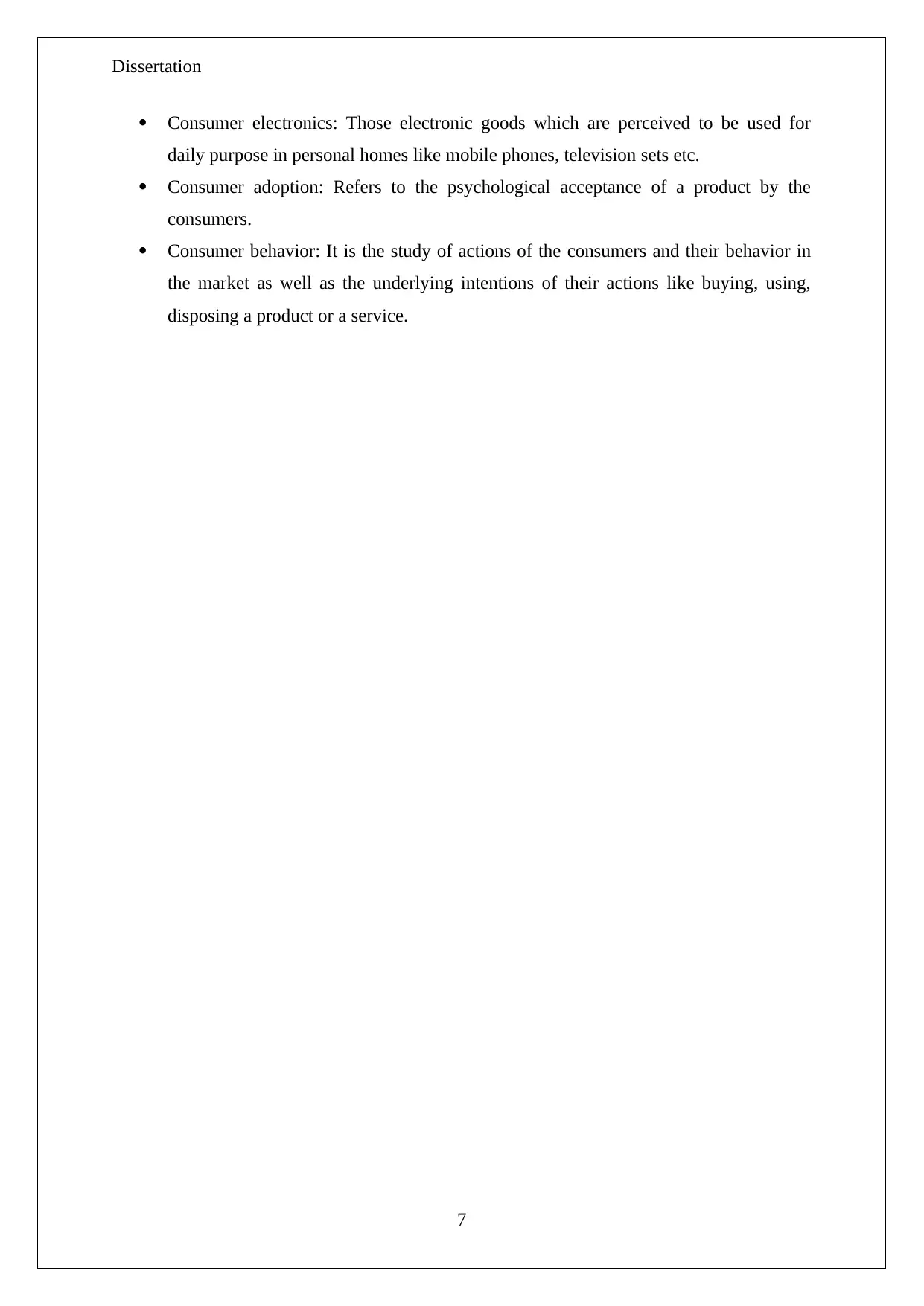
Dissertation
Consumer electronics: Those electronic goods which are perceived to be used for
daily purpose in personal homes like mobile phones, television sets etc.
Consumer adoption: Refers to the psychological acceptance of a product by the
consumers.
Consumer behavior: It is the study of actions of the consumers and their behavior in
the market as well as the underlying intentions of their actions like buying, using,
disposing a product or a service.
7
Consumer electronics: Those electronic goods which are perceived to be used for
daily purpose in personal homes like mobile phones, television sets etc.
Consumer adoption: Refers to the psychological acceptance of a product by the
consumers.
Consumer behavior: It is the study of actions of the consumers and their behavior in
the market as well as the underlying intentions of their actions like buying, using,
disposing a product or a service.
7
Paraphrase This Document
Need a fresh take? Get an instant paraphrase of this document with our AI Paraphraser

Dissertation
References
Chevalier, M., & Mazzalovo, G. (2008). Luxury brand management.
Singapore: John Wiley & Sons (Asia).
Hisense Products. (2019). Retrieved from
https://www.fouanistore.com/hisense-products/
International, E., & International, E. (2019). Consumer Electronics in
Nigeria. Retrieved from https://www.euromonitor.com/consumer-
electronics-in-nigeria/report
Research, M., Goods, C., & Trends, C. (2019). Consumer Electronics
Industry in Nigeria Market Research & Statistics. Retrieved from
https://www.reportlinker.com/ci02060/Consumer-Electronics.html/co
verage/Africa:Nigeria
8
References
Chevalier, M., & Mazzalovo, G. (2008). Luxury brand management.
Singapore: John Wiley & Sons (Asia).
Hisense Products. (2019). Retrieved from
https://www.fouanistore.com/hisense-products/
International, E., & International, E. (2019). Consumer Electronics in
Nigeria. Retrieved from https://www.euromonitor.com/consumer-
electronics-in-nigeria/report
Research, M., Goods, C., & Trends, C. (2019). Consumer Electronics
Industry in Nigeria Market Research & Statistics. Retrieved from
https://www.reportlinker.com/ci02060/Consumer-Electronics.html/co
verage/Africa:Nigeria
8
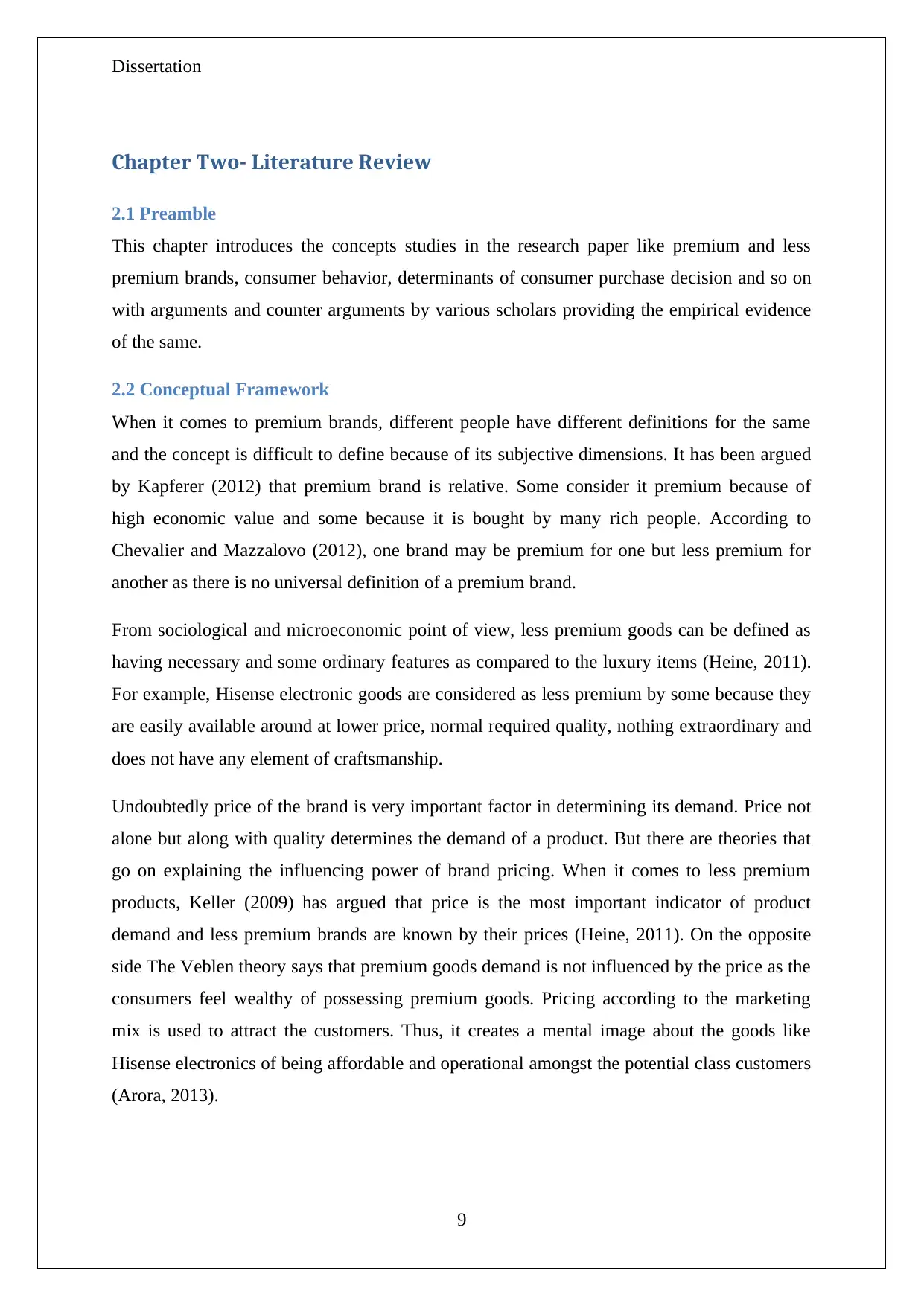
Dissertation
Chapter Two- Literature Review
2.1 Preamble
This chapter introduces the concepts studies in the research paper like premium and less
premium brands, consumer behavior, determinants of consumer purchase decision and so on
with arguments and counter arguments by various scholars providing the empirical evidence
of the same.
2.2 Conceptual Framework
When it comes to premium brands, different people have different definitions for the same
and the concept is difficult to define because of its subjective dimensions. It has been argued
by Kapferer (2012) that premium brand is relative. Some consider it premium because of
high economic value and some because it is bought by many rich people. According to
Chevalier and Mazzalovo (2012), one brand may be premium for one but less premium for
another as there is no universal definition of a premium brand.
From sociological and microeconomic point of view, less premium goods can be defined as
having necessary and some ordinary features as compared to the luxury items (Heine, 2011).
For example, Hisense electronic goods are considered as less premium by some because they
are easily available around at lower price, normal required quality, nothing extraordinary and
does not have any element of craftsmanship.
Undoubtedly price of the brand is very important factor in determining its demand. Price not
alone but along with quality determines the demand of a product. But there are theories that
go on explaining the influencing power of brand pricing. When it comes to less premium
products, Keller (2009) has argued that price is the most important indicator of product
demand and less premium brands are known by their prices (Heine, 2011). On the opposite
side The Veblen theory says that premium goods demand is not influenced by the price as the
consumers feel wealthy of possessing premium goods. Pricing according to the marketing
mix is used to attract the customers. Thus, it creates a mental image about the goods like
Hisense electronics of being affordable and operational amongst the potential class customers
(Arora, 2013).
9
Chapter Two- Literature Review
2.1 Preamble
This chapter introduces the concepts studies in the research paper like premium and less
premium brands, consumer behavior, determinants of consumer purchase decision and so on
with arguments and counter arguments by various scholars providing the empirical evidence
of the same.
2.2 Conceptual Framework
When it comes to premium brands, different people have different definitions for the same
and the concept is difficult to define because of its subjective dimensions. It has been argued
by Kapferer (2012) that premium brand is relative. Some consider it premium because of
high economic value and some because it is bought by many rich people. According to
Chevalier and Mazzalovo (2012), one brand may be premium for one but less premium for
another as there is no universal definition of a premium brand.
From sociological and microeconomic point of view, less premium goods can be defined as
having necessary and some ordinary features as compared to the luxury items (Heine, 2011).
For example, Hisense electronic goods are considered as less premium by some because they
are easily available around at lower price, normal required quality, nothing extraordinary and
does not have any element of craftsmanship.
Undoubtedly price of the brand is very important factor in determining its demand. Price not
alone but along with quality determines the demand of a product. But there are theories that
go on explaining the influencing power of brand pricing. When it comes to less premium
products, Keller (2009) has argued that price is the most important indicator of product
demand and less premium brands are known by their prices (Heine, 2011). On the opposite
side The Veblen theory says that premium goods demand is not influenced by the price as the
consumers feel wealthy of possessing premium goods. Pricing according to the marketing
mix is used to attract the customers. Thus, it creates a mental image about the goods like
Hisense electronics of being affordable and operational amongst the potential class customers
(Arora, 2013).
9
⊘ This is a preview!⊘
Do you want full access?
Subscribe today to unlock all pages.

Trusted by 1+ million students worldwide
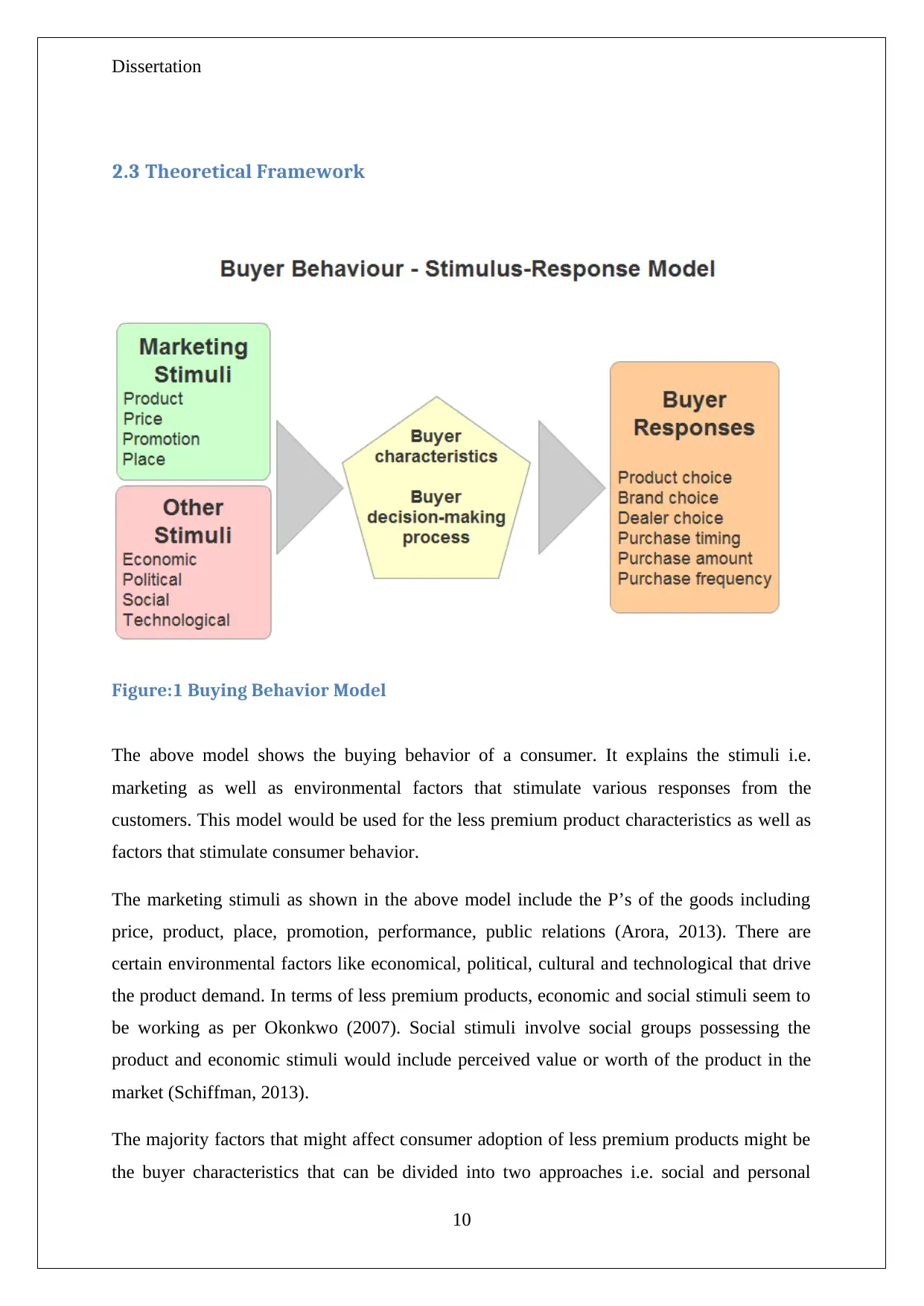
Dissertation
2.3 Theoretical Framework
Figure:1 Buying Behavior Model
The above model shows the buying behavior of a consumer. It explains the stimuli i.e.
marketing as well as environmental factors that stimulate various responses from the
customers. This model would be used for the less premium product characteristics as well as
factors that stimulate consumer behavior.
The marketing stimuli as shown in the above model include the P’s of the goods including
price, product, place, promotion, performance, public relations (Arora, 2013). There are
certain environmental factors like economical, political, cultural and technological that drive
the product demand. In terms of less premium products, economic and social stimuli seem to
be working as per Okonkwo (2007). Social stimuli involve social groups possessing the
product and economic stimuli would include perceived value or worth of the product in the
market (Schiffman, 2013).
The majority factors that might affect consumer adoption of less premium products might be
the buyer characteristics that can be divided into two approaches i.e. social and personal
10
2.3 Theoretical Framework
Figure:1 Buying Behavior Model
The above model shows the buying behavior of a consumer. It explains the stimuli i.e.
marketing as well as environmental factors that stimulate various responses from the
customers. This model would be used for the less premium product characteristics as well as
factors that stimulate consumer behavior.
The marketing stimuli as shown in the above model include the P’s of the goods including
price, product, place, promotion, performance, public relations (Arora, 2013). There are
certain environmental factors like economical, political, cultural and technological that drive
the product demand. In terms of less premium products, economic and social stimuli seem to
be working as per Okonkwo (2007). Social stimuli involve social groups possessing the
product and economic stimuli would include perceived value or worth of the product in the
market (Schiffman, 2013).
The majority factors that might affect consumer adoption of less premium products might be
the buyer characteristics that can be divided into two approaches i.e. social and personal
10
Paraphrase This Document
Need a fresh take? Get an instant paraphrase of this document with our AI Paraphraser
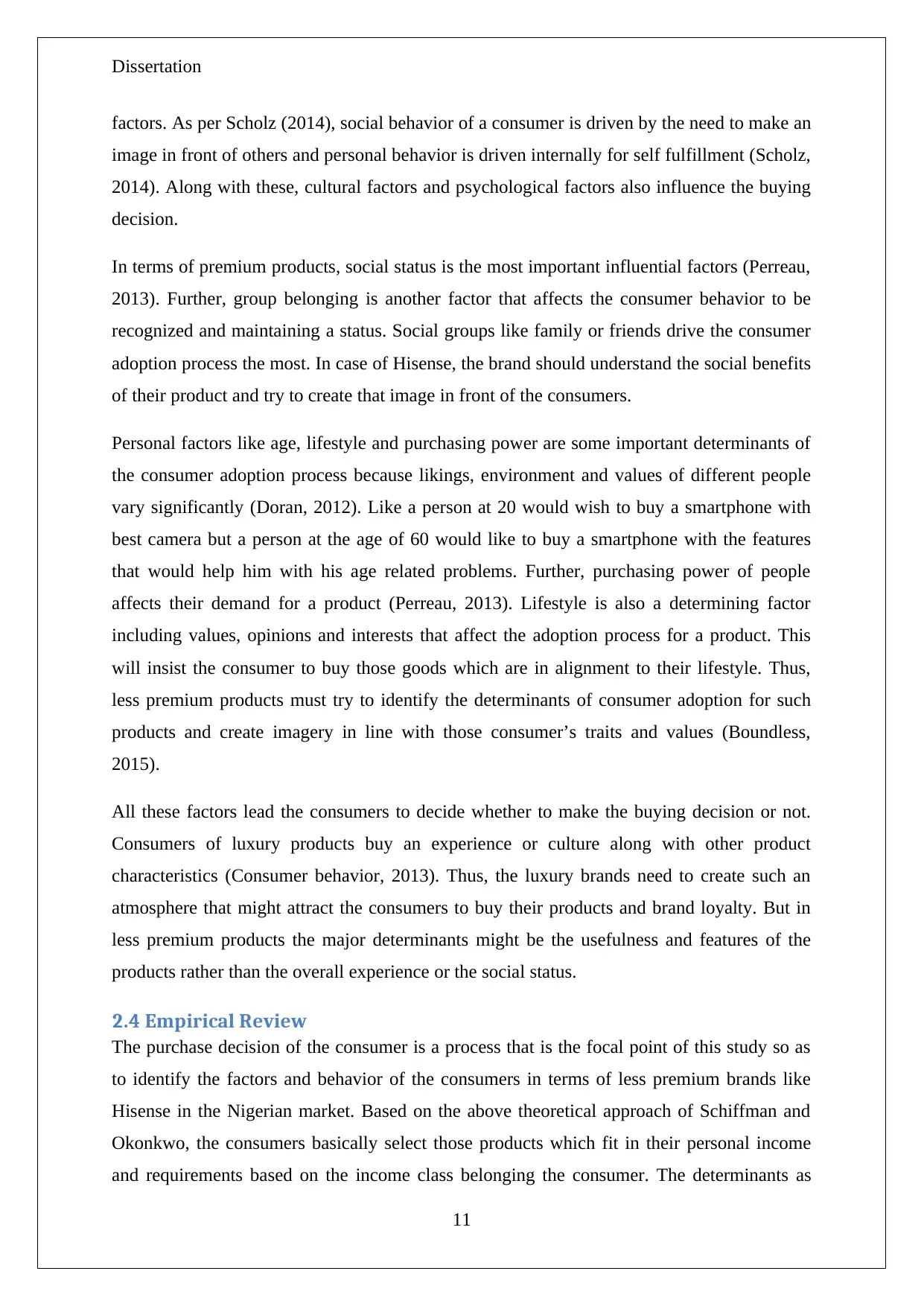
Dissertation
factors. As per Scholz (2014), social behavior of a consumer is driven by the need to make an
image in front of others and personal behavior is driven internally for self fulfillment (Scholz,
2014). Along with these, cultural factors and psychological factors also influence the buying
decision.
In terms of premium products, social status is the most important influential factors (Perreau,
2013). Further, group belonging is another factor that affects the consumer behavior to be
recognized and maintaining a status. Social groups like family or friends drive the consumer
adoption process the most. In case of Hisense, the brand should understand the social benefits
of their product and try to create that image in front of the consumers.
Personal factors like age, lifestyle and purchasing power are some important determinants of
the consumer adoption process because likings, environment and values of different people
vary significantly (Doran, 2012). Like a person at 20 would wish to buy a smartphone with
best camera but a person at the age of 60 would like to buy a smartphone with the features
that would help him with his age related problems. Further, purchasing power of people
affects their demand for a product (Perreau, 2013). Lifestyle is also a determining factor
including values, opinions and interests that affect the adoption process for a product. This
will insist the consumer to buy those goods which are in alignment to their lifestyle. Thus,
less premium products must try to identify the determinants of consumer adoption for such
products and create imagery in line with those consumer’s traits and values (Boundless,
2015).
All these factors lead the consumers to decide whether to make the buying decision or not.
Consumers of luxury products buy an experience or culture along with other product
characteristics (Consumer behavior, 2013). Thus, the luxury brands need to create such an
atmosphere that might attract the consumers to buy their products and brand loyalty. But in
less premium products the major determinants might be the usefulness and features of the
products rather than the overall experience or the social status.
2.4 Empirical Review
The purchase decision of the consumer is a process that is the focal point of this study so as
to identify the factors and behavior of the consumers in terms of less premium brands like
Hisense in the Nigerian market. Based on the above theoretical approach of Schiffman and
Okonkwo, the consumers basically select those products which fit in their personal income
and requirements based on the income class belonging the consumer. The determinants as
11
factors. As per Scholz (2014), social behavior of a consumer is driven by the need to make an
image in front of others and personal behavior is driven internally for self fulfillment (Scholz,
2014). Along with these, cultural factors and psychological factors also influence the buying
decision.
In terms of premium products, social status is the most important influential factors (Perreau,
2013). Further, group belonging is another factor that affects the consumer behavior to be
recognized and maintaining a status. Social groups like family or friends drive the consumer
adoption process the most. In case of Hisense, the brand should understand the social benefits
of their product and try to create that image in front of the consumers.
Personal factors like age, lifestyle and purchasing power are some important determinants of
the consumer adoption process because likings, environment and values of different people
vary significantly (Doran, 2012). Like a person at 20 would wish to buy a smartphone with
best camera but a person at the age of 60 would like to buy a smartphone with the features
that would help him with his age related problems. Further, purchasing power of people
affects their demand for a product (Perreau, 2013). Lifestyle is also a determining factor
including values, opinions and interests that affect the adoption process for a product. This
will insist the consumer to buy those goods which are in alignment to their lifestyle. Thus,
less premium products must try to identify the determinants of consumer adoption for such
products and create imagery in line with those consumer’s traits and values (Boundless,
2015).
All these factors lead the consumers to decide whether to make the buying decision or not.
Consumers of luxury products buy an experience or culture along with other product
characteristics (Consumer behavior, 2013). Thus, the luxury brands need to create such an
atmosphere that might attract the consumers to buy their products and brand loyalty. But in
less premium products the major determinants might be the usefulness and features of the
products rather than the overall experience or the social status.
2.4 Empirical Review
The purchase decision of the consumer is a process that is the focal point of this study so as
to identify the factors and behavior of the consumers in terms of less premium brands like
Hisense in the Nigerian market. Based on the above theoretical approach of Schiffman and
Okonkwo, the consumers basically select those products which fit in their personal income
and requirements based on the income class belonging the consumer. The determinants as
11
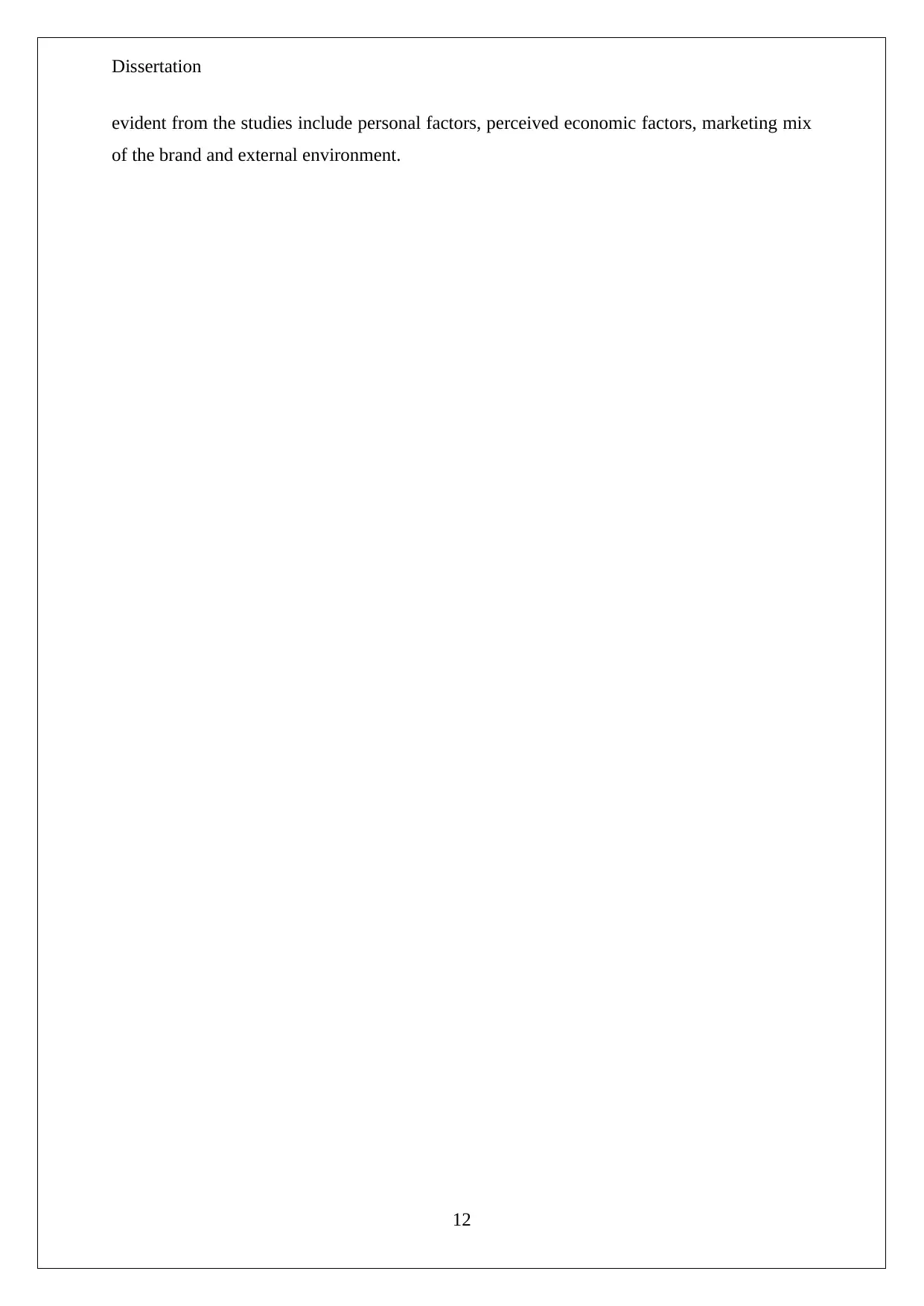
Dissertation
evident from the studies include personal factors, perceived economic factors, marketing mix
of the brand and external environment.
12
evident from the studies include personal factors, perceived economic factors, marketing mix
of the brand and external environment.
12
⊘ This is a preview!⊘
Do you want full access?
Subscribe today to unlock all pages.

Trusted by 1+ million students worldwide
1 out of 29
Your All-in-One AI-Powered Toolkit for Academic Success.
+13062052269
info@desklib.com
Available 24*7 on WhatsApp / Email
![[object Object]](/_next/static/media/star-bottom.7253800d.svg)
Unlock your academic potential
Copyright © 2020–2025 A2Z Services. All Rights Reserved. Developed and managed by ZUCOL.
